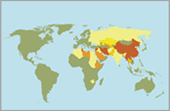 North Korea
North Korea
PDF VersionGovernment restrictions on online content and connectivity render the Democratic People’s Republic of Korea (North Korea) a virtual “black hole” in cyberspace. While shunning Internet accessibility and functionality, Pyongyang has opted for an isolated, domestic intranet consisting of approximately thirty Web sites approved by the government and available only to a privileged minority.
The North Korean regime does maintain a nominal presence on the World Wide Web through sites promoting its ideology and agenda. As with print and broadcast media, these sites largely extol the nation’s leader Kim Jong Il, his father Kim Il Sung, and the Juche Idea of national “self-reliance,” while espousing the country’s stance on reunification of the Korean Peninsula. Unlike other media, however, North Korean Web sites lie at some distance from Pyongyang. Because the state lacks an active top-level domain (TLD), it relies on servers in China, Japan, Germany, and even Texas to host its official pages, including www.korea-dpr.com (North Korea’s Web page) and www.kcna.co.jp (the home page of the state-run Korean Central News Agency). North Korea has asked repeatedly for the country code TLD “.kp”, but the U.S.-based Internet Corporation for Assigned Names and Numbers (ICANN) has yet to grant the request.
ONI did not conduct empirical testing in North Korea. The conclusions in this summary are drawn solely from secondary sources.
Results At A Glance
| FILTERING | No evidence of filtering | Suspected filtering | Selective filtering | Substantial filtering | Pervasive filtering |
|---|---|---|---|---|---|
| Political | No data available at this time. | ||||
| Social | No data available at this time. | ||||
| Conflict/Security | No data available at this time. | ||||
| Internet tools | No data available at this time. | ||||
| OTHER FACTORS | Not Applicable | Low | Medium | High | |
|---|---|---|---|---|---|
| Transparency | No data available at this time. | ||||
| Consistency | No data available at this time. | ||||
Key Indicators
| worst | best | ||
|---|---|---|---|
| Life expectancy at birth (years) | 67 | ||
| Literacy rate (% of people age 15+) | 100 | ||
| Rule of Law (scale of 0-5) | 1.3 | ||
| Voice and Accountability (scale of 0-5) | 0.3 | ||
| EIU Democracy Index (out of 167 countries) | 167 | ||
Internet and Intranet in North Korea
The community of Internet users in North Korea consists almost entirely of elites and foreigners. A select few, including members of Kim Jung Il’s inner circle, enjoy unfiltered Internet access via satellite link to servers in Germany, thanks to a 2004 joint venture between Pyongyang’s Korea Computer Center (KCC) and its Berlin-based counterpart KCC Europe. Most Internet users, however, are dependent upon Chinese service providers for connectivity—and thus are subject to China’s filtering regime. For years, these providers could be reached only via international dialup from exclusive hotels in Pyongyang. In 2002, optical cable connections between the North Korean capital and Shanghai became operational at the Internet PC Room—the first Internet café in the country. Still, few North Koreans can afford the hourly fee of USD10, effectively limiting use of the PC Room to foreign diplomats, businesspersons, journalists, and tourists.
A growing segment of the North Korean population is gaining access to Chinese networks via Web-enabled mobile phones smuggled in from China and sold on the black market.1 However, for most North Koreans, access to online content is exceedingly rare and limited to the few dozen Web sites that comprise Kwangmyong, the nation’s domestic intranet. Content on Kwangmyong is chosen, and user conduct monitored, by the government. Information comes primarily from databases maintained by the Central Scientific and Technological Information Agency, the Grand People’s Study House, and other repositories.2 This content is intended for use at select research institutes, schools, and factories. Aside from these establishments, only government ministries and a handful of enterprises and individuals have the computers, telecommunications capacity, and the authorization needed to utilize the national intranet.
Small, government-sanctioned businesses offering public intranet access have been observed in urban areas, but user fees are likely prohibitive for the average North Korean. In 2005 human rights groups revealed photographs of one such venue—called the Information Technology Store—in the city of Chungjin. The facility houses several terminals with intranet connectivity and offers computer classes at the steep price of 20,000 won per month—seven to eight times the average monthly wage.3 Such costs are believed to be mandated by the state so as to deter ordinary citizens from using the resources and services of these facilities.
Legal and regulatory frameworks
The near absence of connectivity, even to the isolated and heavily filtered Kwangmyong intranet, is consistent with the North Korean regime’s efforts to regulate all information and communication in the country. There are no independent media in North Korea. Personal radios and televisions must be modified to receive only government stations and registered with the authorities. A nationwide ban on mobile phones has also been in place since May 2004.
It is the state’s command of institutions and resources that allows it to achieve such pervasive control over online media. The government allocates available technologies to establishments and authorizes user access as it sees fit. Legal measures play only a subsidiary role in actualizing state control, and for citizens, they confer no actionable rights vis-à-vis the state. Thus, although Article 67 of the DPRK’s Socialist Constitution guarantees freedom of speech and of the press, there is no means of instituting a legal challenge to the state’s dominion over online access and expression.
NOTES
- 1. Rebecca MacKinnon, “Chinese cell phone breaches North Korean hermit kingdom,” YaleGlobal, January 17, 2005, http://yaleglobal.yale.edu/display.article?id=5145.
- 2. Office of the National Counterintelligence Executive, “North Korea: Channeling foreign information technology to leverage IT development,” December 2003, http://www.ncix.gov/archives/docs/NORTH_KOREA_AND_FOREIGN_IT.pdf.
- 3. A. Yang Jung, “Controlling the Internet café in North Korea,” The Daily NK, July 13, 2005, http://www.dailynk.com/english/read.php?cataId=nk00300&num=206.

